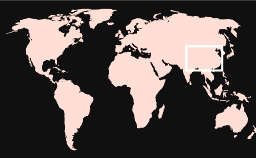|
|
Geography One
of the world’s largest countries by area, China is about the size of the
US and half the size of Russia. One
of the world’s largest countries by area, China is about the size of the
US and half the size of Russia.
The Chinese like to say that theirs is the most mountainous nation in the world, and indeed two-thirds of the country comprises uplands, including the world’s highest mountain, Everest, in Tibet. Most of the population, and the historical heart of China, is by contrast in the relative lowlands in east. The most important feature of Chinese geography is the split between the arid, wheat-growing region in the north, and the hot, humid rice growing region in the south. HistoryOne of history’s first civilizations originated in China some four thousand years ago (after those of Mesopotamia and the Nile Valley, and roughly contemporary with that of the Indus River Valley). The first Chinese Emperor, Qin Shihuangdi, consolidated his rivals in 221 BC. The Mongols finished the job in the 13th century, basically forming the country as it exists today by adding the southern and western parts.The
last emperor abdicated in 1911 in the face of mounting social pressures and
weakness vis-à-vis western imperial powers. Warlords and autocrats reigned until Economic reforms initiated by Mao’s successors beginning in 1979 have created a bustling market economy but no substantive political reforms. They call this “Socialism with Chinese characteristics.” PeoplePopulation of 1.2 billion, one-fifth of the world total. And with a density of about 350 per square mile, it's a great place if you like people. But unless you happen to be among the 93% of the populace that is Han Chinese, the feeling probably won't be mutual: ethnic minorities are officially protected but actually persecuted, and the Chinese are notable for their xenophobia.Mao Zedong Thought is the predominant faith, and according to government statistics is followed by all except troublemakers, who are imprisoned or shot whenever possible. In days gone by, China was fertile ground for Buddhism and originated Taoism and Confucianism. The UN ranks China in the 44th percentile in terms of quality of life, based on life expectancy, education and income; this is about average for an Asian country. EconomyProgressively unshackled since 1979, the Chinese economy has reemerged as one of the world’s largest economies. This is a tribute to the industriousness of the Chinese when allowed to just get on with it.In human terms, however, China is still poor at about $750 GNP per capita. In addition, economic and social dislocations have resulted in mass migrations to the industrialized cities, and resultant urban poverty and homelessness. China is self-sufficient in food (no mean feat), has a wealth of mineral resources and an increasingly diversified industrial base, aided in part by foreign direct investment over the past two decades and a steadfast adherence to unfair trade practices.Sources: World Bank (1998 data), Dorling Kindersley World Reference Atlas, UNDP Human Development Report, Lonely Planet |